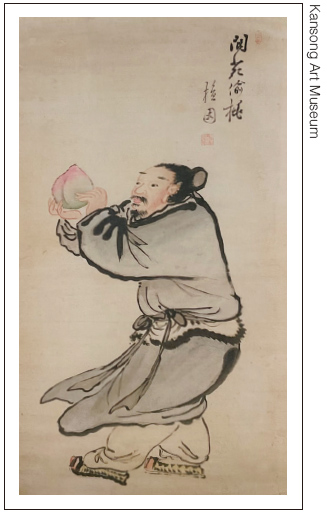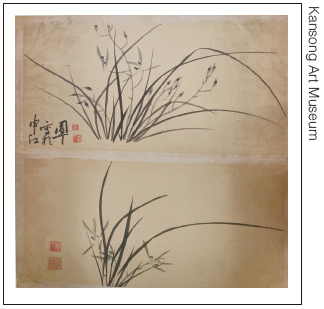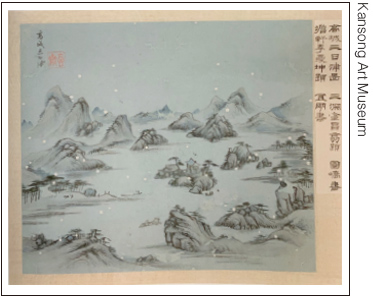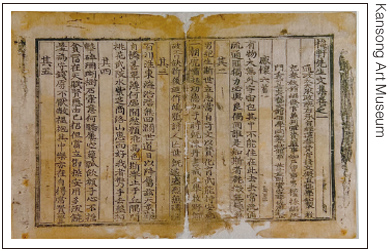Kansong Jeon Hyung-pil (1906–1962) was a Korean art collector and an educationist. In the Japanese colonial era, he devoted himself to collecting and protecting Korean cultural heritages looted by Japanese antique collectors. He gathered hundreds of cultural properties, including 12 National Treasures, 10 Treasures, and four Seoul-designated Tangible Cultural Heritages. His collection includes Goryeo celadon, Hunminjeongeum Haeryebon (*“Hunminjeongeum” is the original name of Hangul, the Korean alphabet, “Haerye” means “to explain and give examples,” and “bon” means “printed volume”), ancient paintings, and calligraphy works. His collection is said to have irreplaceable value to Korean art history studies.
The Kansong Art Museum is the oldest private art museum in Korea. It was established to preserve, study, and display Korean cultural assets collected by Jeon Hyung-pil throughout his life. The Kansong Art Museum was founded in 1938 under the name “Bohwagak,” and later renamed after the founder’s pen name “Kansong.” The Kansong Art Museum is devoted more to research and protection of cultural assets than to exhibitions. Therefore, it only opens to the public twice a year at no entrance fee.
The exhibition, which ran from April 16 to June 5, 2022, was named “Bohwa-Subo.” The theme of the exhibition, subtitled “Meeting the Treasure of Kansong Again,” was “The Restoration and Conservation of the Kansong Collection.”
To systematically preserve and care for the cultural assets collected by Jeon Hyung-pil, the Kansong Art Museum organized a preservation team in the laboratory and has been conducting preservation treatment by diagnosing the condition of about 1,000 artifacts since 2014. In the exhibition, artworks that have been restored for two years from 2020 were displayed.
Nangwontudo
(Stealing a Peach from a Nangwon, in English)

*Danwon Kim Hong-do (c. 1745–1805) was a representative painter in Korea. Although he is known for his genre paintings, he was also an artist who was recognized contemporarily because he mastered all the styles of painting. Nangwontudo is one of Kim Hong-do’s Doseok paintings (figure painting of Taoists, in English). This work depicts a scene in which a Taoist named Dongbangsak steals a peach belonging to the Queen Mother of the West, Xiwangmu, a goddess in Chinese mythology, in Nangwon. The legend says that whoever eats a peach from Nangwon gets to live an extra 60,000 years. Dongbangsak, who stole three peaches from Xiwangmu, is said to have lived 18 million years.
Unmi Nancheop
(*“Nan” means “orchid”; “cheop” means “collection of artworks”)

*Unmi Min Young-ik (1810–1914) was a politician and painter famous for his orchid and bamboo paintings in the late Joseon Dynasty. *Chusa Kim Jeong-hui (1786–1856), a renowned painter known for his series of Mukran (orchid paintings by ink in English), accepted his style. Unmi Nancheop is an essential work in understanding the Mukran style of the period, as it contains the process of forming the artists’ own unique painting style based on the traditional Mukran style and Chusa’s Mukran style.
Samilpo
(*“Sam-il” means “three days”; “Po” means “lake”)

This work has marks due to damage from insects. However, for a long time, the viewer recognized the marks as part of the painting; therefore, the preservation workers did not change much when they were restoring it. Accordingly, marks make the painting look as if it is snowing. Arguably, restoring cultural assets does not necessarily mean returning them to their original form, but sometimes means respecting the changes that have become part of the work overtime.
Maeheon Sonsaeng Munjip
(*“Sonsaeng” means “teacher” or “Mister”; “Munjip” means “literary work collection”)

*Maeheon Kwon Woo (1363–1419), the author of Maeheon Sonsaeng Munjip, was a bureaucrat at the end of the Goryeo Dynasty and early Joseon Dynasty. He studied under Jeong Mong-ju, a famous scholar and politician in the late Goryeo Dynasty. Kwon Woo was also a teacher who taught many famous scholars in the early Joseon Dynasty. The collection is a valuable material that indicates the thoughts and spirit of Kwon Woo, who lived through a period of political and social turbulence. After the Joseon Dynasty was established, the name “Jeong Mong-ju” was erased from the collection because the past Goryeo Dynasty bureaucrats were suppressed after the change of reign. It is possible to assume how the life of the author would have been through this collection. The collection at the Kansong Art Museum was published in 1452 and has great value as a rare collection of poems from the early Joseon Dynasty.

Everything gets old and fades over time – as is the law of nature. Therefore, repairing and preserving cultural properties is an attempt to confront time, while also showing the human aspiration for eternity. On June 5, the Kansong Art Museum is scheduled to finish its exhibition of Bohwa-Subo and begin large-scale renovations. Because of this, the second floor of the museum building was empty. The bright sunlight entered the room through the windows on three sides, and the visitors could see the green trees swaying outside. Impressive was the contrast between the collections and the museum building, both expected to last another indefinite amount of time.
Kansong Art Museum
Location: 102-11, Seongbuk-ro, Seongbuk-dong, Seongbuk-gu, Seoul, Republic of Korea
Homepage: https://kansong.org/
E-mail: kansong@kansong.org
Hwang Yun-seon
mono071227@uos.ac.kr

